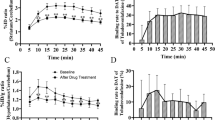Abstract
Tetrahydroaminoacridine (THA), an acetylcholinesterase inhibitor that is reported to have significant effects on cognition and memory in Alzheimer’s disease patients, binds to rat brain membranes in a saturable and reversible manner. Computer analysis of the binding data revealed high- and low-affinity sites with K d values of 97.8 nM and 4.65 µM and B max values of 4.13 and 114 pmol/mg protein. Autoradiographic studies show that these binding sites are not co-localized with acetylcholinesterase activity. The binding of [3H]THA to membranes does not appear to be related to receptors for several neurotransmitters/neuromodulators, including acetylcholine and other acetylcholinesterase inhibitors. Amiridin, a closely related acetylcholinesterase inhibitor, was able to block specific [3H]THA binding (IC50 = 1.05 µM). While the function of THA mediated by these sites is unknown, they may be responsible in part for the distinct clinical effects of tetrahydroaminoacridine compared to other acetylcholinesterase inhibitors.
Similar content being viewed by others
REFERENCES
P. J. Whitehouse, D. L. Price, R. G. Struble, A. W. Clark, J. T. Coyle, and M. R. DeLong. Alzheimer's disease and senile dementia: loss of neurons in the basal forebrain. Science 215:1237–1239 (1982).
D. A. Drachman and J. Leavitt. Human memory and the cholinergic system, Arch. Neurol. 30:113–121 (1974).
L. J. Thal, W. Rosen, N. S. Sharpless, and H. Crystal. Choline chloride fails to improve cognition of Alzheimer's disease. Neurobiol. Aging 2:205–208 (1983).
W. D. Boyd, J. Graham-White, G. Blackwood, I. Glen, and J. McQueen. Clinical effects of choline in Alzheimer senile dementia. Lancet 2:711 (1977).
S. D. Brinkman, N. Pomara, P. J. Goodnick, N. Barnett, and E. F. Domino. A dose-ranging study of lecithin in the treatment of primary degenerative dementia (Alzheimer disease). J. Clin. Psychopharmacol. 2:281–285 (1982).
J. E. Christie, A. Sherring, J. Ferguson, and A. I. M. Glen. Physostigmine and arecoline: Effects of intravenous infusion in Alzheimer presenile dementia. Br. J. Psychiat. 138:46–50 (1981).
K. L. Davis and R. C. Mohs. Enhancement of memory process in Alzheimer's disease with multiple-dose intravenous physostigmine. Am J. Psychiat. 139:1421–1424 (1982).
K. L. Davis, R. C. Mohs, J. R. Tinklenberg, A. Pfeffebaum, L. E. Hollister, and B. S. Kopell. Physostigmine: Improvements of long-term memory processes in normal humans. Science 201:272–274 (1978).
W. K. Summers, L. V. Majovski, G. M. Marsh, K. Tachiki, and A. Kling. Oral tetrahydroaminoacridine in long-term treatment of senile dementia, Alzheimer type. N. Engl. J. Med. 315:1241–1245 (1986).
P. N. Kaul. Enzyme inhibiting activity of tetrahydroaminoacridine and its structural fragments. J. Pharm. Pharmacol. 14:243–248 (1962).
B. Drukarch, K. S. Kits, E. G. Van der Meer, J. C. Lodder, and J. C. Stoof. 9-Amino-l,2,3,4-tetrahydroaminoacridine (THA), an alleged drug for the treatment of alzheimer's disease inhibits acetylcholinesterase activity and slow outward K+ current. Eur. J. Pharm. 141:153–157 (1987).
D. R. Stevens and C. W. Cotman. Excitatory action of tetrahydro-9-amino acridine (THA) on hippocampal pyramidal neurons. Neurosci. Lett. 79:301–305 (1987).
C. L. Schauf and A. Sattin. Tetrahydroaminoacridine blocks potassium channels and inhibits sodium inactivation in Myxicola. J. Pharm. Exp. Ther. 243:609–613 (1987).
B. Drukarch, J. E. Leysen, and J. C. Stoof. Further analysis of the pharmacological profile of 9-amino-1,2,3,4-tetrohydroamino acridine (THA). Life Sci. 42:1011–101 (1988).
E. G. Gray and V. P. Whittaker. Isolation of nerve endings from brain: An electron microscope study of cell fragments derived by homogenization. J. Anat. 96:79–87 (1962).
G. K. Ellman, K. D. Courtney, V. Andres, and R. M. Featherstone. A new and rapid colorimetric determination of acetylcholinesterase activity. Biochem. Pharmacol. 7:88–95 (1961).
G. B. Koelle and J. S. Fridenwald. A histochemical method for localizing cholinesterase activity. Proc. Soc. Exp. Biol. Med. 70:617–622 (1949).
P. K. Smith, R. I. Krohn, G. T. Hermanson, A. K. Mallia, F. H. Gartner, M. D. Provenzano, E. K. Fujimoto, N. M. Goeke, B. J. Olson, and D. C. Klenk. Measurement of protein using bicinchoninic acid. Anal. Biochem. 150:76–85 (1985).
H. Feldman, D. Rodbard, and D. Levine. Mathematical theory of cross-reaction radioimmunoassay and ligand-binding systems at equilibrium. Anal. Biochem. 45:530–556 (1972).
W. S. Young and M. J. Kuhar. A new method for receptor autoradiography: [3H]opiod receptors in rat brain. Brain Res. 179:255–270 (1979).
J. A. Nielsen, E. E. Mena, I. H. Williams, M. R. Nocerini, and D. Liston. Correlation of brain levels of THA with neurochemical and behavioral changes. Eur. J. Pharm. 173:53–64 (1989).
W. McNally, M. Roth, R. Young, H. Bockbrader, and T. Chang. Quantative whole-body autoradiographic determination of tacrine tissue distribution in rats following intravenous or oral dose. Pharm. Res. 6:924–930 (1989).
C. Braestrup and R. F. Squires. Specific benzodiazepine receptors in rat brain characterized by high-affinity [3H]diazepam binding. Proc. Natl. Acad. Sci. USA 74:3805–3809 (1977).
P. J. Roberts. Glutamate receptors in the rat central nervous system. Nature 252:339–401 (1974).
G. L. Craviso and J. M. Musacchio. High-affinity dectromethorphan binding sites in guinea pig brain. I. Initial characterization. Mol. Pharmacol. 23:619–628 (1983).
S. R. Zukin and R. S. Zukin. Specific [3H]phencyclidine binding in rat central nervous system. Proc. Natl. Acad. Sci. USA 76:5372–5376 (1979).
Author information
Authors and Affiliations
Rights and permissions
About this article
Cite this article
Mena, E.E., Desai, M.C. High-Affinity [3H]THA (Tetrahydroaminoacridine) Binding Sites in Rat Brain. Pharm Res 8, 200–203 (1991). https://doi.org/10.1023/A:1015840003630
Issue Date:
DOI: https://doi.org/10.1023/A:1015840003630




